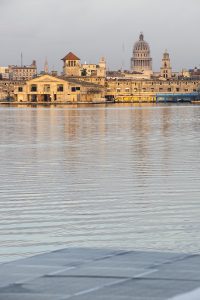“What are microplastics?” “How does your city manage its waste?” “You’ve been able to set up a solar power plant in your region!” “I’ve been fighting for more renewable energy for 30 years, and between solar power and your ship, I’m even more convinced.” Those are some comments overheard during a conversation between Cuban environmental specialists at the Plastic Waste to Energy workshop held on board Race for Water in Havana on July 24.
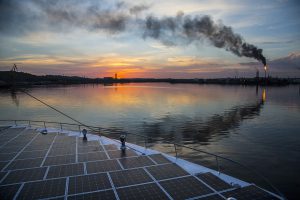
Sharing ideas to move forward
“Everyone at this event is an expert in their field (geology, biology, economics, physics, etc.). But they all need a chance to talk things over and think about their ideas. That’s the goal of these meetings,” explains Camille Rollin, a specialist with the Race for Water Foundation’s Plastic Waste to Energy projects.
At every Race for Water stopover, Camille joins the crew to organize and lead these discussions. “It’s energizing and enriching for our mission—preserving the oceans—we need to learn about and understand the geographic, historical, and environmental constraints in every country we visit. We’re all aware that we need to preserve the environment. But we all have our own ideas about how to get there. When we understand the context, we can suggest real-world solutions—like the technology that we developed with our partners at ETIA. It transforms plastic waste into energy; plastic then becomes valuable, and it’s a new way for garbage pickers on the streets to earn money.”
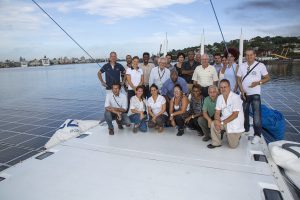
A variety of viewpoints
During this workshop, 27 Cuban experts from diverse backgrounds came together to talk about diverse topics. Moderator Manuel Fernadez Rondón from the l’Agencia de Energia Nuclear y Technologías de Avanzada allowed Arianna García Chamero, a biologist from CITMA (Ministerio de Ciencia, Tecnología y Medio Ambiente) to speak first. She presented findings from her unpublished study on the effects of microplastics on the Cuban marine ecosystem, and her data probably came as a surprise to many experts who knew nothing about these plastic particles, much less the environmental risks that they represent. Odalys C. Goicochea Cardoso, CITMA’s environmental director, then shed some light on Cuba’s environmental policies, and on the laws and standards that are planned for the future, to bring much-needed improvements to air and water quality. Havana Bay is a sad reminder of the work that still needs to done: Race for Water was anchored directly offshore from an oil refinery that sits just steps from Havana’s historic downtown. The crew was forced to breathe highly polluted air, and the Bay itself is a sailor’s nightmare, with plastic bottles and bags floating amid hydrocarbon slicks. A plan to move the refinery is being studied, but it’s a huge project and funding has to be secured.
CITMA’s Anaelys Saunders Vázquez then spoke about the many projects to increase Cuba’s renewable energy supply that are in process or being studied. Although the island enjoys abundant sunshine year-round, there is very little in the way of solar power. Dr. Julio C Rimada Herrera, a physicist at the Cátedra de Energía Solar de la Universidad de la Habana agreed, and spoke to the island’s potential for major photovoltaic installations. Last to speak was CEAC-CITMA’s Tatiana Alonso Pérez, who discussed the situation in the city of Cienfuegos. The city has a recycling center that handles plastic—PET, PE, and PA. While the current processing volumes are still too low, the initiative is still there, and in a municipality that has only two official landfills and numerous unofficial open-air dumps, most of which are near the water.
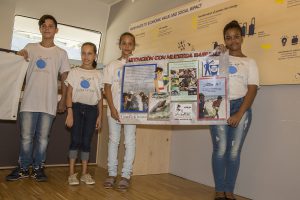
Cubans are slowly but surely becoming more environmentally-conscious; two out of the five main principles of environmental responsibility—repairing and reusing—are already ingrained in the islanders’ habits. Everyone seems to be pitching in, and associations like Acualina—which educates the public and especially children about these issues—are helping. “Some projects might take time to come to fruition, but we still have to believe in them,” an excellent reminder to the Race for Water Foundation, from Luís Berriz Perez, president of the Cuban society for the promotion of renewable energy. That association has been fighting for some 30 years to develop solar power in Cuba, and they followed the first Race for Water—then called Planet Solar—on its world tour in 2010. This workshop gave Perez the long-awaited opportunity to be on board the new Race for Water, and he reports that the improvements offered by the new solar-hydrogen-kite system have given him enough inspiration for the next 30 years.
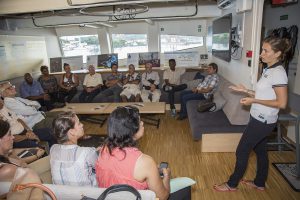
Camille closed the meeting with a reminder that in order to meet the challenges of the 21st century, efforts need to come from all sides. “Of course we always think about regulations first, but if we want to effectively fight plastics pollution in the oceans, the best solution is for each of us to reduce the amount of waste that we generate. Putting some of the responsibility on manufacturers, especially packaging manufacturers, is also key. When they’re designing their products, they absolutely must think about what happens to those products when they’re done being used. And the Plastic Waste to Energy solution that the Foundation is promoting fits a variety of different waste management contexts, even in isolated locations. It’s a small to medium-capacity technical solution that takes a decentralized approach to waste management and energy production. It’s already been proven to be efficient and effective. Plastic waste could be the next addition to the energy mix that Race for Water is promoting.”
